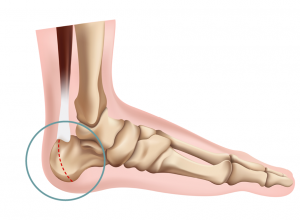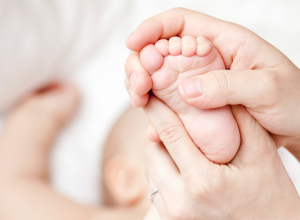
Sever’s Disease
Sever’s disease, also called calcaneal apophysitis, is a bone disorder commonly experienced by children and young adolescents. Though painful, it is usually not serious and has no long-term effects.
Causes
Though its name sounds a bit terrifying, Sever’s disease is not a disease but rather a temporary, non-serious heel injury that typically affects children between the ages of 8 and 15. It is caused by inflammation of the epiphyseal plate (also called a growth plate) in the heel, which is an area in the developing feet of children where cartilage cells are slowly forming into bone cells. Though it’s a normal process, this transformation of cells causes the growth plate to expand, causing intense pain. Additionally, the rapid growth of the epiphyseal plate stretches the leg muscles and irritates the Achilles tendon (the tendon that connects the calf muscle to the heel bone). Repeated stress from activities like running, jumping, gymnastics and sports puts pressure on the unusually tight muscles and Achilles tendon, which then creates even more pain, tightness and inflammation in the heel area.
Sever’s disease typically occurs during the period children experience rapid growth spurts (between the ages of 8 and 13 for girls, 10 and 15 for boys) and has a tendency to affect physically active children in greater numbers. The condition is rarely seen in adolescents over the age of 15, as foot bones are typically full grown and fused together by that age.
Some conditions that can increase a child’s chance of developing Sever’s disease include:
- Poor fitting shoes that rub the back of the heel
- Under or over pronation, which creates additional stress on the Achilles tendon
- Obesity or extra weight, which adds pressure to the epiphyseal plate
- Flat or high arched feet, which further irritates the Achilles tendon
- Short leg syndrome (when one leg is shorter than the other), which irritates the Achilles tendon on the shorter leg because the foot is forced to bend in order to touch the ground
Symptoms
In addition to heel pain that affects the plantar and side areas of the foot as well as the ankle, Sever’s disease can also cause difficulty walking, a change in gait (limping), swelling and redness in the back of the foot, stiffness in the heel after periods of sleep or inactivity, and pain when the heel is squeezed.
Treatment
Because activity is generally what irritates the Achilles tendon and epiphyseal plate, most doctors recommend that children who have Sever’s disease refrain from too much physical activity. Depending on each child’s situation, this could be a decrease in activity and sports or it could be outright avoiding all activities that cause pain.
Some other treatment options include foot and leg exercises and stretches that lengthen and loosen the muscles and tendons, applying ice to reduce pain and swelling, wearing compression socks to further reduce pain and swelling, and taking over-the-counter medication like Tylenol, Advil or Motrin. (Never give a child aspirin for pain relief, as it has been linked to a serious condition called Reye syndrome.)
In rare cases, your child’s doctor may suggest he or she wear a cast for several weeks to take pressure off of the foot bones and tendons while they grow and fuse together.
If obesity or other foot conditions like flatfoot or pronation issues are the cause of your child’s Sever’s disease, your doctor may recommend that he or she lose weight and/or wear special shoe inserts or orthotic devices while the foot continues to grow.
The sooner Sever’s disease is addressed, the sooner your child can heal and resume normal activity.
Long-Term Affects and Recurrence
With proper care and rest, most cases of Sever’s disease will go away within a couple of weeks to a couple of months and have no long-lasting effects on your child or his or her health. However, delays in care and treatment may create chronic pain and/or recurrence of Sever’s disease. Recurrence risk dissipates around the age of 15, when a child’s foot bones are fully fused together.
Prevention
One of the best ways to prevent Sever’s disease is to make sure your child wears properly fitted shoes appropriate for the type of activities he or she is engaging in. Shoes that are well padded or have shock-resistant soles further help to protect the foot and reduce pressure on the heel.
Foot and leg stretches help keep the tendons and muscles loose and pain free. And if your child is overweight, shedding the extra pounds can help prevent Sever’s disease.
Notice concerning medical entries:
Articles having medical content shall serve exclusively for the purpose of general information. Such articles are not suitable for any (self-) diagnosis and treatment of individual illnesses and medical indications. In particular, they cannot substitute for the examination, advice, or treatment by a licensed physician or pharmacist. No replies to any individual questions shall be effected through the articles.







